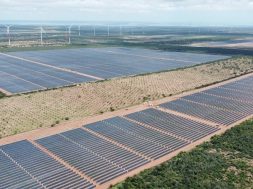Japan Seeks Silicon Valley for Energy Storage in Shadow of Fuji
A patch of land in the shadow of Mount Fuji is becoming a testing ground for energy storage, with some of Japan’s leading companies trying to develop technologies such as spinning flywheels and fuel cells.
The government of Yamanashi, a prefecture 102 kilometers (63 miles) west of Tokyo, is hoping that by attracting companies such as Panasonic Corp. and Toray Industries Inc. it can become a kind of Silicon Valley for energy storage development.
As part of a project in Kofu City, the prefecture has built a 1-megawatt solar power station that’s being made available to developers of storage devices who want to run tests under closed conditions, according to Masaki Sakamoto, an official in charge of the project.
“It’s not easy to find a large-scale solar power station available for pilot projects,” Sakamoto said. “The best scenario would be that advanced research being conducted here leads to more collaboration between major and local companies and the creation of supply chains.”
Projects like the one in Yamanashi underline how Japan is racing to dominate a new age of energy technologies using a model similar to the one used by the nation to develop its automobile and semiconductor industries.
The site in Yamanashi, one of Japan’s sunniest regions, is already home to a flywheel system in a pilot program to adjust output from the solar plant. Flywheel storage devices use spinning drums to store kinetic energy in a way that can later be turned into electricity.
Flywheels, Batteries
The device at the Yamanashi facility, set up by the Railway Technical Research Institute, uses a superconducting magnetic bearing that allows the wheel to spin with a minimum of friction. The superconducting technology is an offshoot of work the institute developed for trains that operate using magnetic levitation. A maglev train is being run through its paces on a test track in Yamanashi.
“With flywheels, it is possible to customize the device’s output power and storage capacity individually,” said Ken Nagashima, director for the maglev systems technology division at the institute, “They are also resistant to repeated charging and discharging and do not produce harmful wastes.”
In November, the site added a system based on a modified nickel metal hydride battery developed by a startup called Exergy Power Systems Inc. The system has enhanced durability compared with typical nickel metal hydride batteries widely used in hybrid vehicles, according to a statement by the prefecture.
Rooftop solar panels and a small hydro generator provide power to a one-story building that serves as the visitor center at the site. Surplus power is used to produce hydrogen through electrolysis using a device developed by Kobelco Eco-Solutions Co., a unit of Kobe Steel Ltd. The hydrogen is then stored in a tank to be used for fuel cells installed by Panasonic to produce electricity when power supply from rooftop solar is low.
Storage Devices
Energy storage comes in different types to adjust the flow of clean energy in varying duration. Aside from pumped hydro — the most prevalent storage technology for grid connected projects — batteries, flywheels, and hydrogen are increasingly becoming important.
Along with the U.S., Japan is among the top markets for energy storage, according to Bloomberg New Energy Finance. The country will have cumulative energy storage of 7,440 megawatts by 2024, up from 847 megawatts this year, according to Bloomberg New Energy Finance estimates.
“This kind of experiment is important because customers want data on the performances of different technologies to decide what storage technologies they want to use,” Ali Izadi-Najafabadi, an analyst for London-based BNEF, said.
The Yamanashi project is also boosting the prefecture’s efforts to transform itself into a “Fuel Cell Valley” to attract talent and investment. Japan wants to showcase hydrogen-related technologies when Tokyo hosts the 2020 Olympic Games.
Japan is leading the global market in residential fuel cells after the first such devices hit the commercial market in 2009. With hydrogen still not readily available, home fuel cells in Japan use city gas delivered through existing pipes to extract hydrogen.
Panasonic’s prototypes at the Yamanashi facility use “pure” hydrogen produced by Kobelco’s machine in anticipation that hydrogen will be supplied to each household in the future.
‘Special Zone’
“This is a secluded area like a special zone which allows us to conduct various experiments,” Yuichi Shimizu, a Panasonic official, said. “We are hoping to turn the device into something you can just put on the wall outside your house like a gas water heater. We need to work on making it smaller, more efficient and more durable.”
Companies including Toray and Tokyo Electric Power Co. Holdings Inc. are studying the feasibility of setting up a system to produce hydrogen from solar power produced from larger plants such as a 10-megawatt plant built nearby by Tepco and the prefecture in 2012, according to Sakamoto. The study is funded by the New Energy and Industrial Technology Development Organization, which also supports Exergy and provided support for the early stages of the flywheel program.
“I agree that this project is unique given the size and the variety of technologies,” said Marianne Boust, a Paris-based analyst for IHS Inc. “But other countries are implementing similar pilot projects like Germany, Italy and South Korea. All these countries are concerned by fast renewable penetration and the impact on the grid.”
Technologies such as fuel cells and power-to-gas are predicted to play a role beyond 2020 “when renewable penetration will be very high,” she said.















